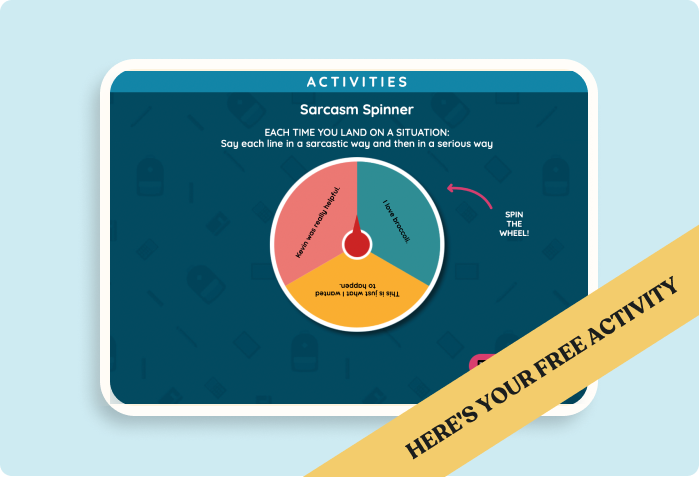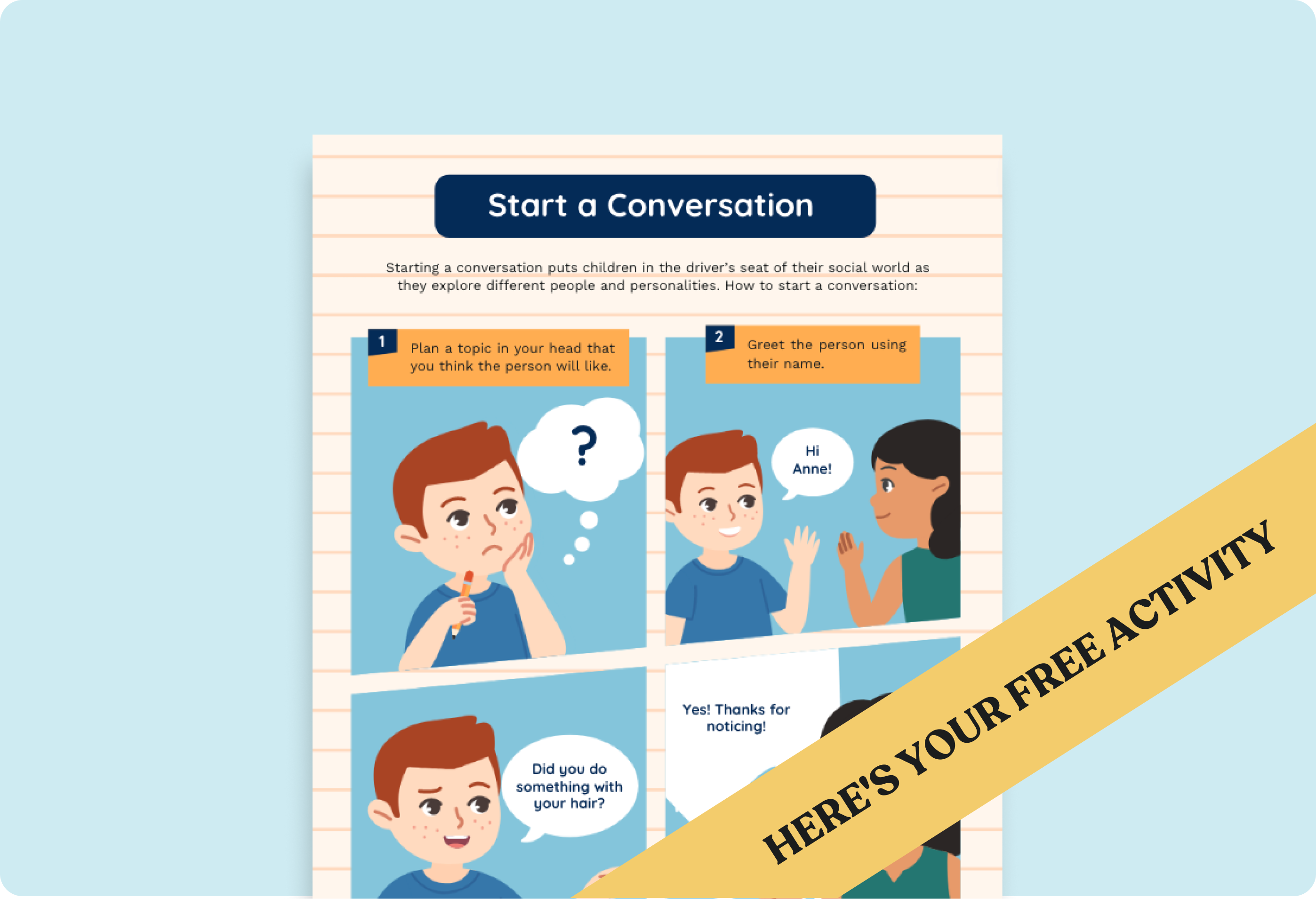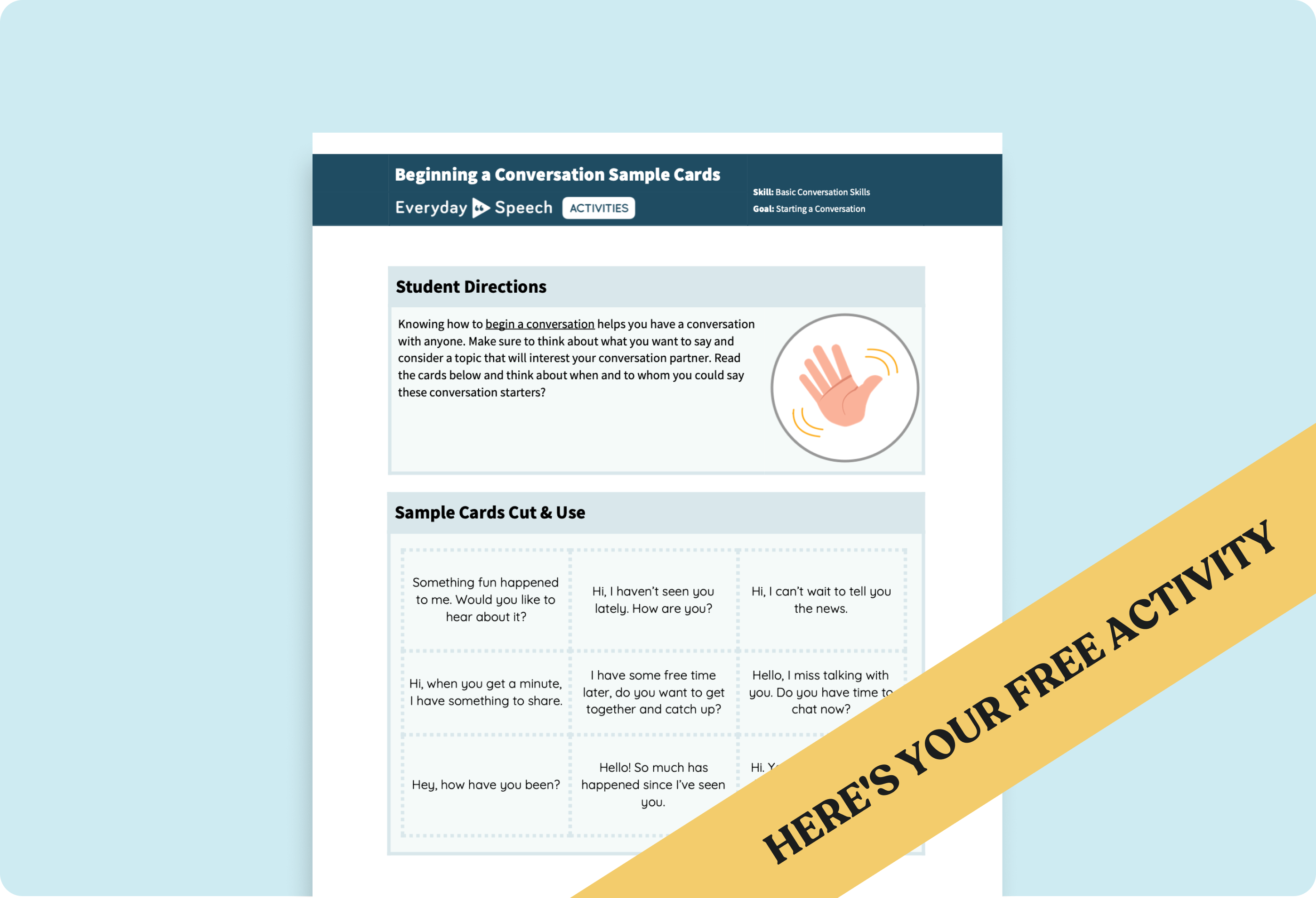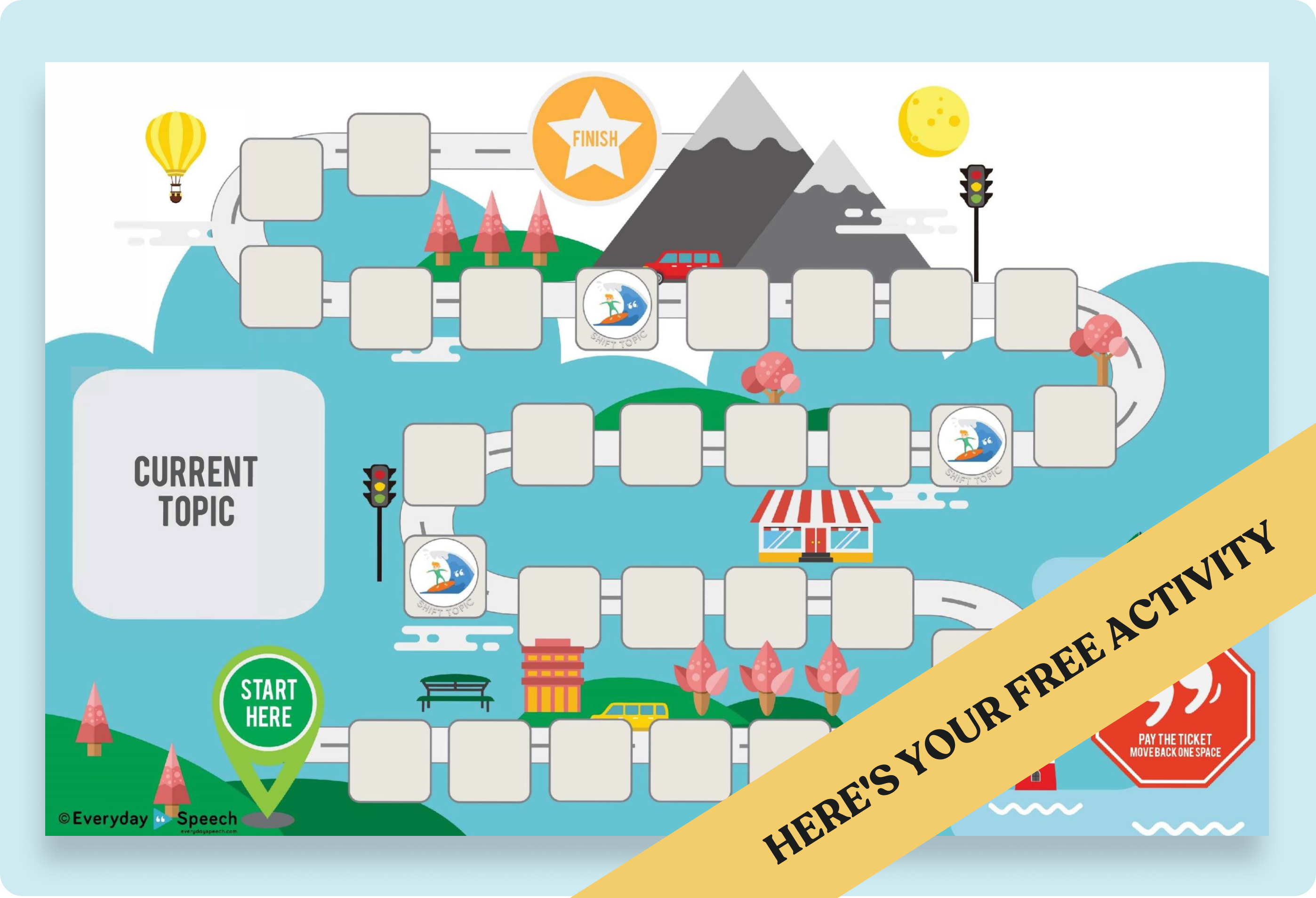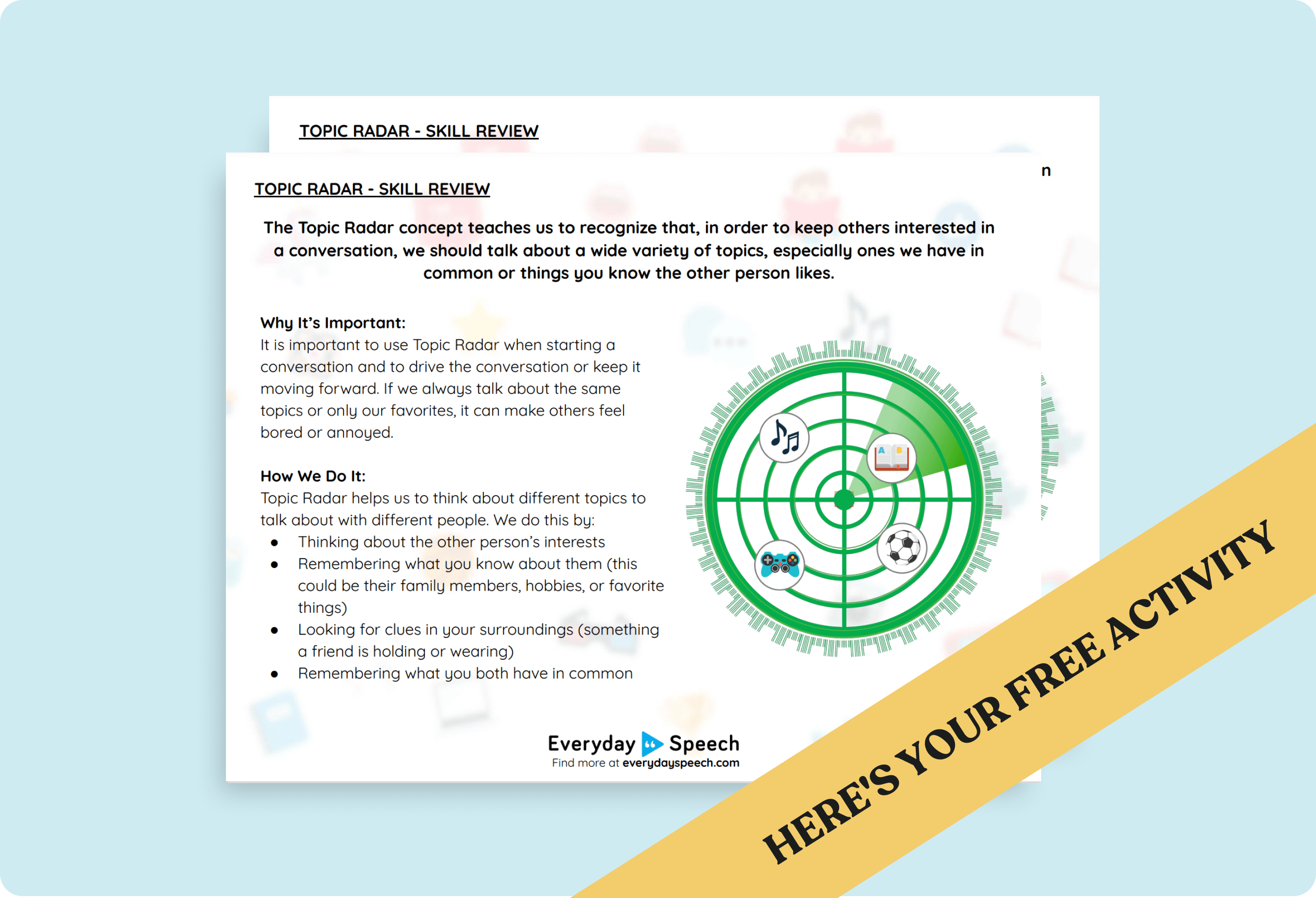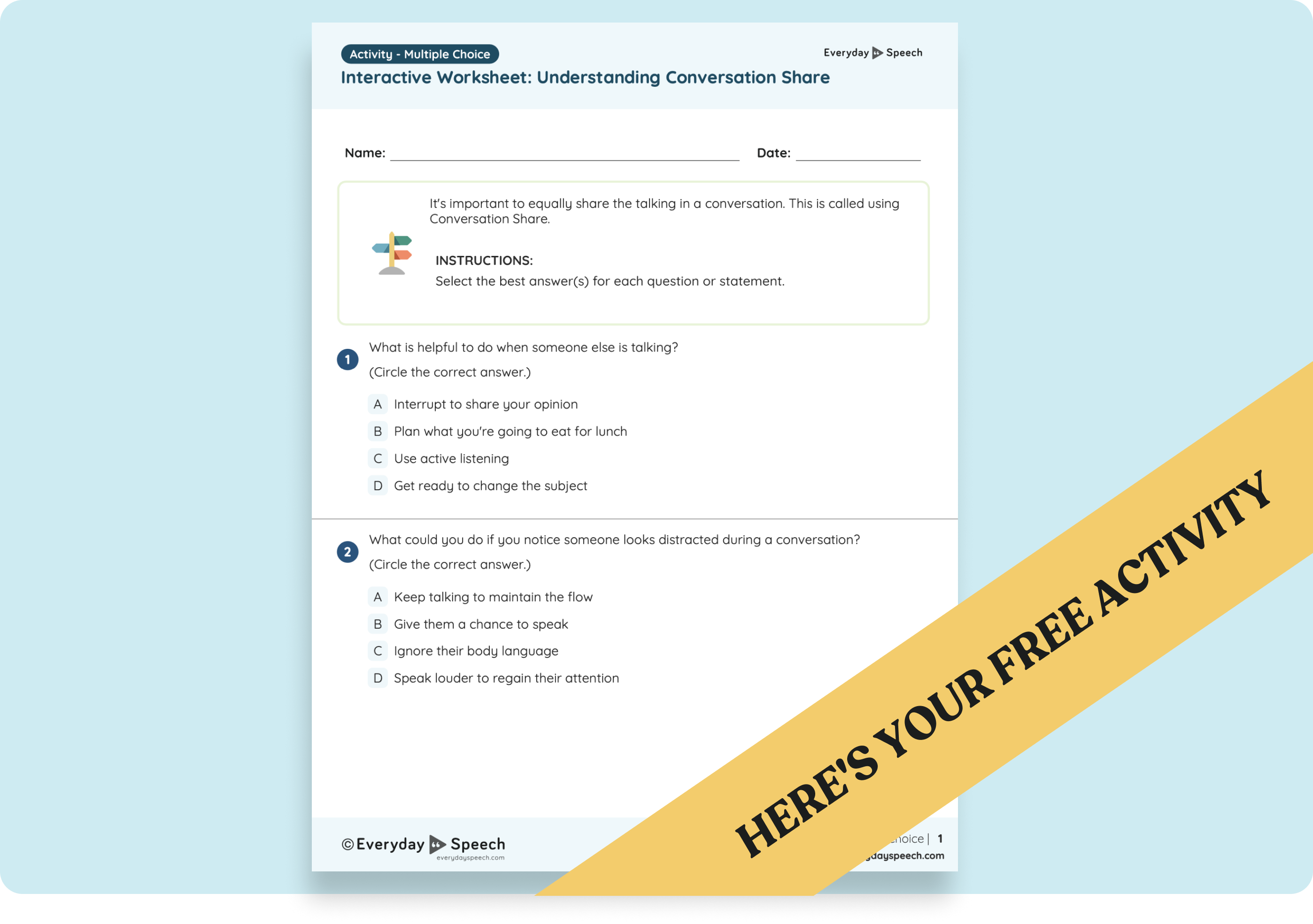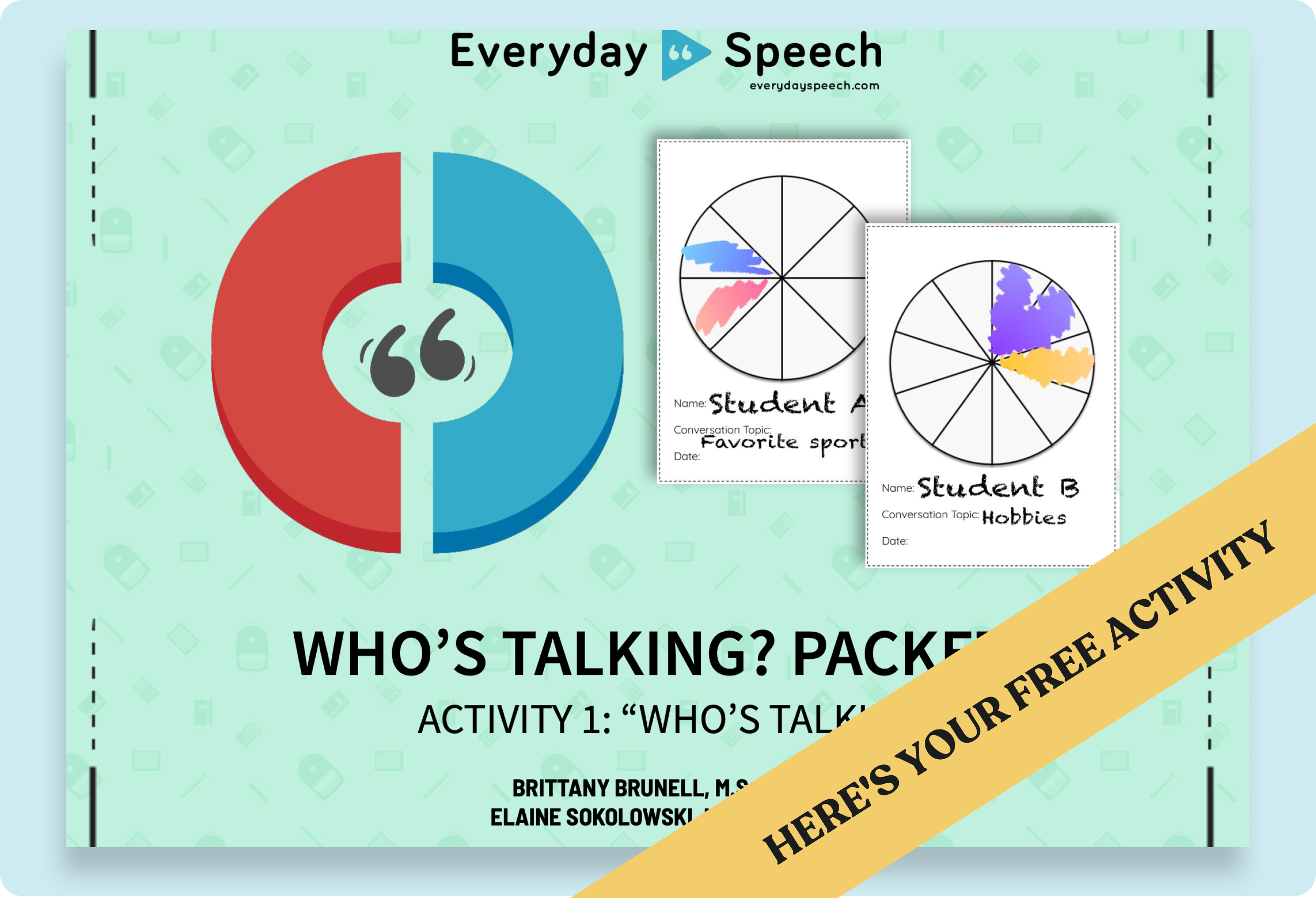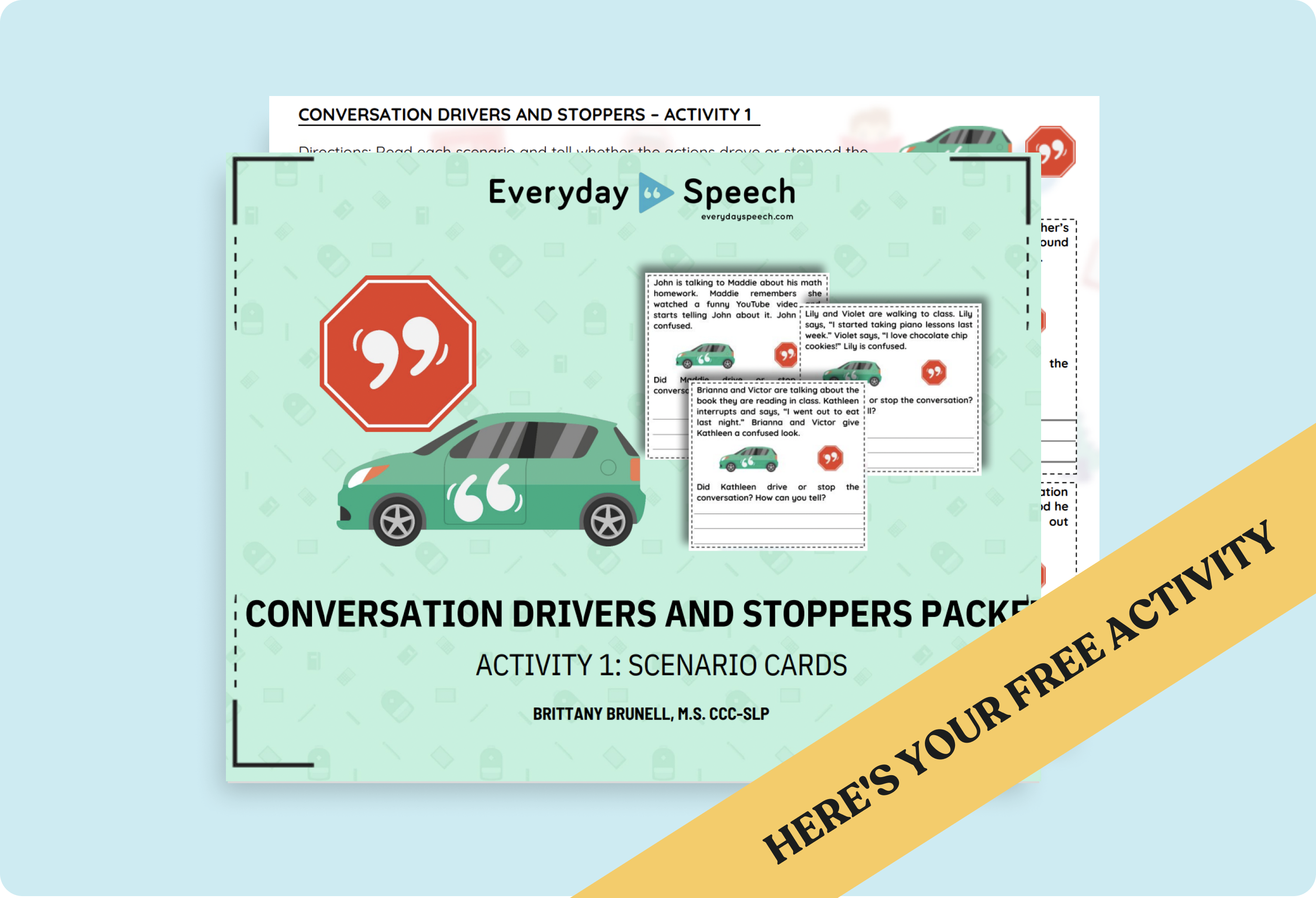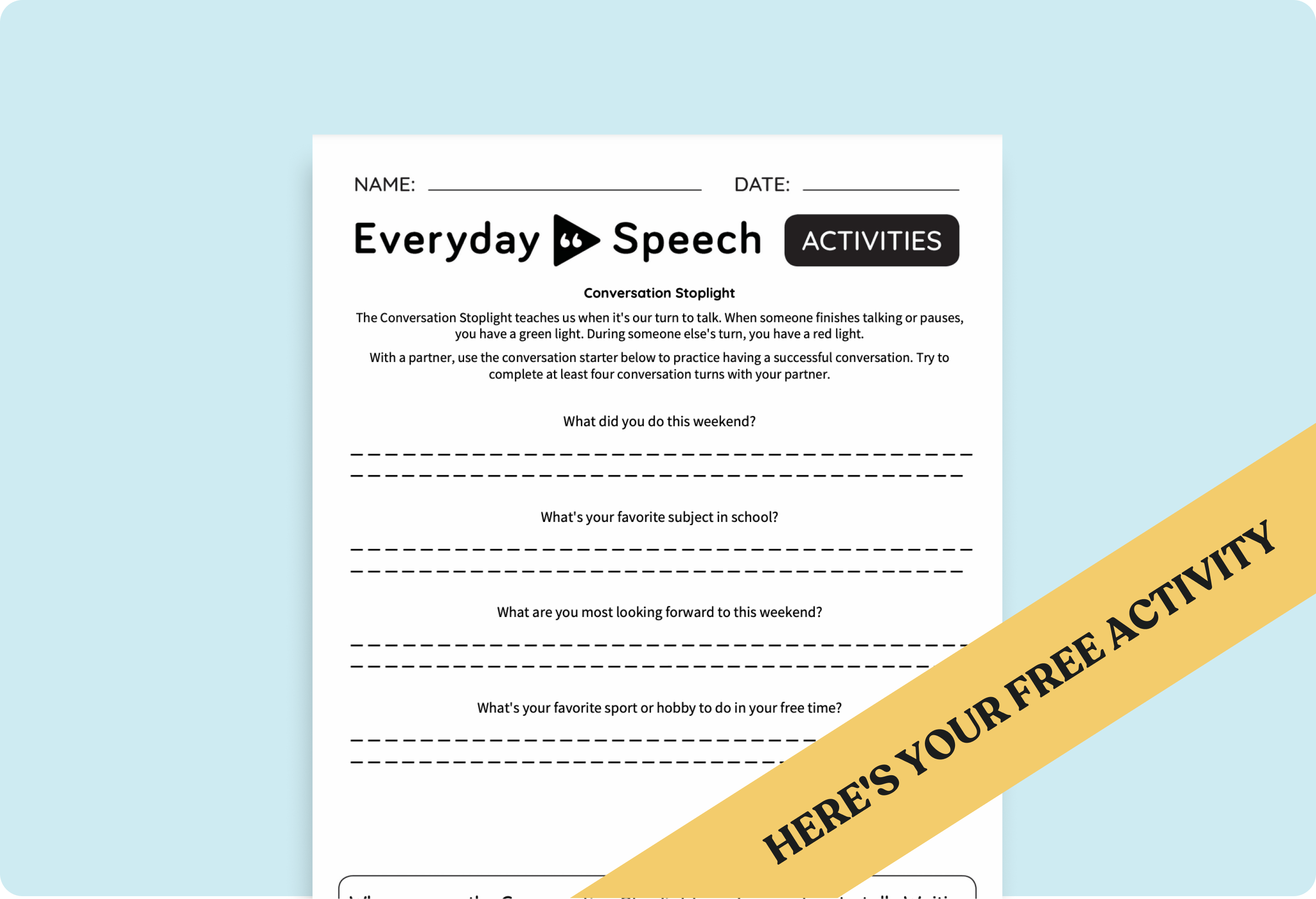Conversation Skills Activities for High School Students
Get free social skills materials
No-prep lessons on self-regulation, emotional recognition, conversation skills, and more.
Sign up hereBy high school, conversations become more nuanced. Students are expected to shift between informal peer interactions and more formal exchanges with adults, adjust their tone and language, and handle topics that are increasingly complex or sensitive.
Strong conversation skills impact everything from group projects to job interviews. They shape how students advocate for themselves, connect with others, and show leadership. But many teens still need direct instruction to communicate clearly and respectfully across settings.
This page brings together free, no-prep resources to help high schoolers build confidence and fluency across three core areas: starting and sustaining conversations, staying engaged and on topic, and using advanced communication strategies like humor, sarcasm, and conversational give-and-take.
Activities to Teach Conversation Skills
Help students start, maintain, and deepen peer interactions with no-prep printables and lessons.
What Are Conversation Skills for High School Students?
By high school, students are expected to navigate increasingly complex social dynamics—both in and out of the classroom. Whether it’s contributing to a group project, initiating conversation in new settings, or interpreting sarcasm, these moments require more than basic social skills.
At this stage, students benefit from direct instruction that emphasizes intentional communication, awareness of tone and audience, and flexibility in how they contribute to conversations. High school instruction often focuses on:
- Initiating and Sustaining Conversations: Using appropriate openers, maintaining flow, and adjusting based on context
- Topic Awareness and Maintenance: Staying relevant, shifting smoothly, and recognizing when to pause or contribute
- Advanced Pragmatic Skills: Understanding sarcasm, balancing humor, managing conversation tone, and reading nuanced cues
These skills form the foundation for peer relationships, job readiness, and self-advocacy in real-world settings.
Why Teach Conversation Skills in High School?
High school students are navigating more abstract expectations in communication—whether it’s contributing to a group discussion, navigating social situations with new peers, or preparing for life after graduation. And while many students appear socially competent, gaps in pragmatic language can still impact:
- Group work and classroom participation
- Job interviews and workplace communication
- Peer dynamics and relationship building
- Conflict resolution and advocacy
Even small communication missteps—interrupting, misusing sarcasm, dominating a conversation—can have outsized effects in high school settings. Structured instruction helps students build confidence and clarity in how they express themselves.
Free High School Conversation Skills Activities
Each of the following activities targets a core conversation skill and includes a lesson plan or printable worksheet. Use them during advisory, in small-group instruction, or 1:1 speech-language sessions.
Activities to Teach Conversation Skills
Help students start, maintain, and deepen peer interactions with no-prep printables and lessons.
1. Sarcasm Spinner: Pragmatics Activity for High School
Skill Focus: Advanced Conversation Skills
This interactive activity teaches students how sarcasm works in social contexts. They’ll learn how tone, timing, and audience influence how sarcastic comments are received. The sarcasm activity for high school encourages reflection on intent and impact while building awareness of how language choices affect others.
Instructional Tips:
- Use student-generated examples to explore intent vs. impact
- Let students categorize statements as playful, confusing, or hurtful
- Practice interpreting sarcasm with the spinner prompts
2. Starting a Conversation Poster
Skill Focus: Conversation Basics
This poster outlines key steps for beginning a conversation — from reading the setting to choosing a friendly opener. The starting a conversation poster reduces anxiety around peer interaction and supports repeated practice in real-life situations.
Instructional Tips:
- Pair the poster with real-life observation tasks (e.g., hallway greetings)
- Use role-plays to rehearse openers with different peers or staff
- Display the poster where peer interaction is encouraged
3. High School Conversation Cards
Skill Focus: Conversation Basics
These printable cards give students structured prompts to start and extend conversations. Prompts cover everyday topics and support repeated practice in a variety of settings. The conversation cards for high school make a great warm-up tool for group work or advisory.
Instructional Tips:
- Use in warm-up rounds before group discussions
- Let students create new cards based on current events or personal interests
- Use as a reflection tool: Which card helped you learn something new?
4. Conversation GPS Packet
Skill Focus: Conversation Maintenance
This packet uses a visual metaphor to help students plan and navigate a conversation “route.” It introduces topic transitions, follow-ups, and adjustments for different contexts. The conversation GPS packet reinforces connected thinking and smoother peer interactions.
Instructional Tips:
- Use visuals to walk through a sample “route” of a conversation
- Let students draw their own GPS flowchart based on a peer exchange
- Reinforce during current events discussions or book talks
5. Topic Radar Lesson Plan
Skill Focus: Conversation Maintenance
This lesson helps students identify and choose conversation topics based on shared interests and context. The radar metaphor makes abstract decisions more tangible, giving students a framework for gauging what’s relevant. The topic radar lesson plan is especially useful for prepping students for interviews, group work, or peer collaboration.
Instructional Tips:
- Build a classroom “topic radar” wall with student ideas
- Practice identifying shared interests in small groups
- Use during partner interviews or get-to-know-you games
6. Understanding Conversation Share
Skill Focus: Balanced Participation
This visual tool introduces the concept of balanced participation in conversations. Students reflect on how much space they take up and how to encourage turn-taking. The conversation share worksheet supports self-monitoring and more thoughtful peer exchanges.
Instructional Tips:
- Use reflection prompts after group work: “How much did you talk?”
- Track participation using tallies or visuals
- Pair with self-monitoring checklists
7. Conversation Share Partner Packet
Skill Focus: Balanced Participation
This packet builds on the concept of balance by guiding students through structured turn-taking activities. Prompts help them deepen conversations and practice staying on topic. The conversation share partner packet is a strong tool for building independence in paired interactions.
Instructional Tips:
- Assign rotating partners to keep practice fresh
- Use sentence starters and turn-taking visuals as supports
- Encourage feedback: “What did your partner do well in this exchange?”
8. Conversation Drivers and Stoppers
Skill Focus: Conversation Maintenance
This activity helps students recognize what keeps a conversation going — and what shuts it down. It builds awareness of tone, interest, and body language. The conversation drivers and stoppers activity is a helpful supplement to group norms or peer discussion routines.
Instructional Tips:
- Create anchor charts of “drivers” and “stoppers” from real examples
- Let students act out both types in role-plays
- Use video clips to spot conversation derailers in action
9. Conversation Stoplight
Skill Focus: Conversation Basics
This visual introduces a red-yellow-green system for thinking before speaking. Students learn how to pause, reflect, and respond appropriately in social settings. The conversation stoplight tool builds self-regulation and reduces impulsivity during group work or discussions.
Instructional Tips:
- Practice with real scenarios: “When would you pause here?”
- Pair with social stories or reflection sheets after group work
- Use to prep for presentations or peer interviews
How to Integrate These Activities into Your Day
This section can parallel the one from the middle school pillar with a few adjusted phrases to reflect the increased independence and self-awareness of high schoolers. Suggested copy:
Conversation instruction at the high school level works best when embedded into authentic, real-life settings. These strategies can help you introduce and reinforce skills across academic and social environments.
- Model with Real Scenarios: Choose a skill (e.g., shifting topics or starting conversations), then model how it shows up in peer interactions, class discussions, or community settings. Use the activity as a springboard to explore nuance.
- Use Peer Role-Plays and Discussion Starters: High schoolers benefit from seeing the direct impact of communication choices. Structure partner or small-group practice where students compare strategies and give each other feedback.
- Incorporate Visuals in Planning Spaces: Tools like posters or worksheets can be used during advisory, life skills courses, or transition planning sessions. Pair them with personal goal-setting or self-assessments.
- Give Timely Feedback: Use low-stakes moments (e.g., group work, casual conversation) to offer in-the-moment reminders or reinforcement. Encourage students to reflect on tone, timing, and clarity.
- Make It Practical: Connect skills to upcoming events like interviews, student leadership roles, or workplace scenarios. Frame the activities as ways to prepare—not just for school, but for life.
Building Communication Confidence
Social language doesn’t stop evolving in high school. In fact, for many students, this is where it gets the most complex. Whether a student is navigating group dynamics, applying for jobs, or simply trying to build stronger peer connections, pragmatic conversation skills are key.
The free resources on this page give students a concrete way to understand and practice these skills. Use them to build fluency, flexibility, and awareness—then watch your students grow in both confidence and connection.
